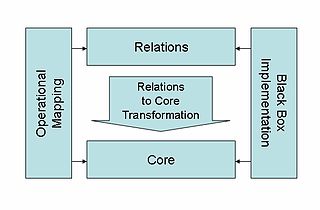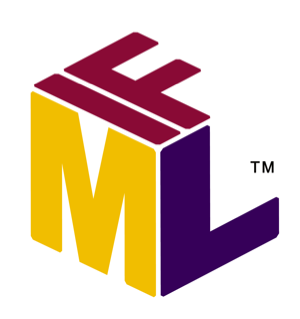Related Research Articles
The XML Metadata Interchange (XMI) is an Object Management Group (OMG) standard for exchanging metadata information via Extensible Markup Language (XML).

The Meta-Object Facility (MOF) is an Object Management Group (OMG) standard for model-driven engineering. Its purpose is to provide a type system for entities in the CORBA architecture and a set of interfaces through which those types can be created and manipulated. The official reference page may be found at OMG's website.
A platform-independent model (PIM) in software engineering is a model of a software system or business system that is independent of the specific technological platform used to implement it.
Model Driven Architecture (MDA) is a software design approach for the development of software systems. It provides a set of guidelines for the structuring of specifications, which are expressed as models. Model Driven Architecture is a kind of domain engineering, and supports model-driven engineering of software systems. It was launched by the Object Management Group (OMG) in 2001.
The Object Constraint Language (OCL) is a declarative language describing rules applying to Unified Modeling Language (UML) models developed at IBM and is now part of the UML standard. Initially, OCL was merely a formal specification language extension for UML. OCL may now be used with any Meta-Object Facility (MOF) Object Management Group (OMG) meta-model, including UML. The Object Constraint Language is a precise text language that provides constraint and object query expressions on any MOF model or meta-model that cannot otherwise be expressed by diagrammatic notation. OCL is a key component of the new OMG standard recommendation for transforming models, the Queries/Views/Transformations (QVT) specification.
A transformation language is a computer language designed to transform some input text in a certain formal language into a modified output text that meets some specific goal.
The common warehouse metamodel (CWM) defines a specification for modeling metadata for relational, non-relational, multi-dimensional, and most other objects found in a data warehousing environment. The specification is released and owned by the Object Management Group, which also claims a trademark in the use of "CWM".

A metamodel or surrogate model is a model of a model, and metamodeling is the process of generating such metamodels. Thus metamodeling or meta-modeling is the analysis, construction and development of the frames, rules, constraints, models and theories applicable and useful for modeling a predefined class of problems. As its name implies, this concept applies the notions of meta- and modeling in software engineering and systems engineering. Metamodels are of many types and have diverse applications.
Model-driven engineering (MDE) is a software development methodology that focuses on creating and exploiting domain models, which are conceptual models of all the topics related to a specific problem. Hence, it highlights and aims at abstract representations of the knowledge and activities that govern a particular application domain, rather than the computing concepts.

ATL is a model transformation language and toolkit developed and maintained by OBEO and AtlanMod. It was initiated by the AtlanMod team. In the field of Model-Driven Engineering (MDE), ATL provides ways to produce a set of target models from a set of source models.

QVT (Query/View/Transformation) is a standard set of languages for model transformation defined by the Object Management Group.
A model transformation language in systems and software engineering is a language intended specifically for model transformation.
Kermeta is a modeling and programming language for metamodel engineering.
Tefkat is a model transformation language and a model transformation engine. The language is based on F-logic and the theory of stratified logic programs. The engine is an Eclipse plug-in for the Eclipse Modeling Framework (EMF).
SmartQVT is a unmaintained full Java open-source implementation of the QTV-Operational language which is dedicated to express model-to-model transformations. This tool compiles QVT transformations into Java programs to be able to run QVT transformations. The compiled Java programs are EMF-based applications. It is provided as Eclipse plug-ins running on top of the EMF metamodeling framework and is licensed under EPL.
Knowledge Discovery Metamodel (KDM) is a publicly available specification from the Object Management Group (OMG). KDM is a common intermediate representation for existing software systems and their operating environments, that defines common metadata required for deep semantic integration of Application Lifecycle Management tools. KDM was designed as the OMG's foundation for software modernization, IT portfolio management and software assurance. KDM uses OMG's Meta-Object Facility to define an XMI interchange format between tools that work with existing software as well as an abstract interface (API) for the next-generation assurance and modernization tools. KDM standardizes existing approaches to knowledge discovery in software engineering artifacts, also known as software mining.
Architecture-driven modernization in computing and computer science, is the name of the initiative of the Object Management Group related to building and promoting standards that can be applied to modernize legacy systems. The objective of this initiative is to provide standard representations of views of existing systems, in order to enable common modernization activities, such as code analysis and comprehension, and software transformation.
In computer programming, bidirectional transformations (bx) are programs in which a single piece of code can be run in several ways, such that the same data are sometimes considered as input, and sometimes as output. For example, a bx run in the forward direction might transform input I into output O, while the same bx run backward would take as input versions of I and O and produce a new version of I as its output.

The Interaction Flow Modeling Language (IFML) is a standardized modeling language in the field of software engineering. IFML includes a set of graphic notations to create visual models of user interactions and front-end behavior in software systems.
References
- ↑ Czarnecki; Helsen (2006). "Feature-based survey of model transformation approaches". IBM Systems Journal. 45 (3): 621–645. CiteSeerX 10.1.1.124.9674 . doi:10.1147/sj.453.0621.
- ↑ Stevens, Perdita (2008). "A Landscape of Bidirectional Model Transformations". Generative and Transformational Techniques in Software Engineering II. Lecture Notes in Computer Science. Vol. 5235. Springer. pp. 408–424. doi:10.1007/978-3-540-88643-3_10. ISBN 978-3-540-88642-6.
- ↑ Jakumeit; Buchwald; Wagelaar; Dan; Hegedüs; Herrmannsdörfer; Horn; Kalnina; Lano; Lepper; Rensink; Rose; Wätzoldt; Mazanek (2014). "A survey and comparison of transformation tools based on the transformation tool contest". Science of Computer Programming. 85: 41–99. doi: 10.1016/j.scico.2013.10.009 .
- ↑ Tom Mens, Pieter Van Gorp: A Taxonomy of Model Transformation. Electr. Notes Theor. Comput. Sci. 152: 125-142 (2006)
- ↑ Stevens, Perdita (2010). "Bidirectional model transformations in QVT: semantic issues and open questions" (PDF). Software and Systems Modeling. 9: 7–20. doi:10.1007/s10270-008-0109-9. S2CID 371579.
- ↑ Tisi, Massimo (2009). "On the Use of Higher-Order Model Transformations". Model Driven Architecture - Foundations and Applications. pp. 18–33. doi:10.1007/978-3-642-02674-4_3. ISBN 978-3-642-02673-7.
{{cite book}}:|journal=ignored (help)